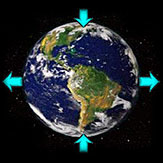Is Earth Getting Fatter Around the Belt?
 Besides being used for transmission of this email message to you, communication satellites are used for some neat science. By shooting a laser beam onto them and measuring how long it takes for light to bounce back, scientists at NASA measure precise orbits of a number of satellites and hence the Earth's gravitational field as a function of longitude and latitude. NASA has been making these measurements for the last 25 years and it turns out the results are quite interesting.
Besides being used for transmission of this email message to you, communication satellites are used for some neat science. By shooting a laser beam onto them and measuring how long it takes for light to bounce back, scientists at NASA measure precise orbits of a number of satellites and hence the Earth's gravitational field as a function of longitude and latitude. NASA has been making these measurements for the last 25 years and it turns out the results are quite interesting.
According to the satellite data, prior to 1998, Earth's gravitational field had been decreasing at the equator and increasing at the poles. Since Earth is shaped like a pumpkin, wider at the equator and narrower at the poles, this means that our planet was getting more spherical or thinner at the equator. This is consistent with how the melting of large ice mass from the poles since the last Ice Age would affect the Earth's shape. Namely, once the pressure from the ice was gone, the ground at the poles actually expanded outward.
Data since 1998 shows an abrupt change in this trend. Earth's gravitational field is increasing now at the equator! Is the Earth getting fatter around the belt? Only significant movement in ocean water, polar and glacial ice, or atmosphere could account for these changes. Scientists are still not sure what the answer is, but some early research findings suggest it may be the movement in ocean water. Somehow, ocean currents gather large quantities of water around the equator every once in a while. Some scientists suggest that this is a cyclic event, but data is still inconclusive.
About the Author
Anton Skorucak, MS
 Anton Skorucak is a founder and publisher of ScienceIQ.com. Anton Skorucak has a Master of Science (MS) degree in physics from the University of Southern California, Los Angeles, California and a B.Sc. in physics with a minor in material science from the McMaster University, Canada. He is the president and creator of PhysLink.com, a comprehensive physics and astronomy online education, research and reference web site.
Anton Skorucak is a founder and publisher of ScienceIQ.com. Anton Skorucak has a Master of Science (MS) degree in physics from the University of Southern California, Los Angeles, California and a B.Sc. in physics with a minor in material science from the McMaster University, Canada. He is the president and creator of PhysLink.com, a comprehensive physics and astronomy online education, research and reference web site.


